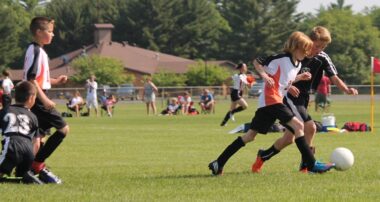Understanding How Physical Health Supports Language Development
Physical health plays a crucial role in a child’s overall development. Researchers have shown that engaging in regular physical activity is linked to improved academic performance. For instance, kids who are physically active tend to have better cognitive abilities and stronger verbal skills. This is vital since language development forms the foundation for successful communication. Increased blood flow and oxygenation of the brain during exercise contribute to enhanced brain function. Moreover, physical fitness is associated with higher self-esteem, which can influence a child’s willingness to engage in language-rich environments. When children feel good about their physical abilities, they are often more willing to participate in discussions and express themselves. Schools promoting physical fitness often see students with increased attention spans, leading to better listening and comprehension skills. These skills are necessary for language acquisition. Also, when children participate in team sports, they learn new vocabulary related to the activity, further enhancing their language skills. Therefore, encouraging physical health is not just about fitness; it’s a fundamental aspect of fostering children’s language development and academic success.
The Brain-Body Connection
The connection between the brain and body is profound. When children are physically active, their brains release endorphins, neurotransmitters that improve mood and reduce stress. This not only helps children feel better but also enhances their ability to learn. Stress can hinder cognitive functions, including language skills. Consequently, physical activity serves as a natural stress reliever, allowing children to focus better on their studies. Research indicates that children who regularly participate in sports or exercise typically display better emotional regulation. Improved mood and reduced anxiety create a conducive learning environment, supporting language development. Additionally, coordination and motor skills gained through physical activities also lend themselves to better hand-eye coordination, which is important for writing and reading comprehension. Team sports often involve communication and strategy discussions, providing natural opportunities for children to practice and enhance their language skills. Furthermore, the social dynamics of these activities foster interactions that require verbal communication. The exposure to diverse vocabulary and conversational styles enriches children’s language experience, benefiting their overall academic performance as well. Thus, encouraging regular physical activity among children can lead to significant language advancements.
Physical education in schools plays an important role in fostering fitness, which benefits language development. Schools with robust physical education programs offer students the chance to engage in structured activities daily. These programs not only promote overall wellness but also create an outdoor environment ripe for learning. In such settings, kids learn not just about sports, but develop social skills, teamwork, and communication. They engage in conversations about strategies and rules, thereby reinforcing their language skills. For instance, discussing plays in a basketball game requires vocabulary related to the sport, thereby enhancing their language. Additionally, physical education teachers can integrate language learning with fitness activities, creating cross-curricular connections that emphasize the importance of both fields. Activities like storytelling during physical games can encourage creativity and expression, reinforcing narrative skills. Furthermore, schools that invest in outdoor play and fitness activities generate excitement among students, making them more likely to engage with language-based tasks. Children are likely to remember vocabulary used in an active context better than during passive learning. Consequently, physical education becomes a unique platform for integrating fitness, language, and academic performance, supporting holistic child development.
Social Interaction and Communication
Regular engagement in physical activities fosters social interaction among children. Team sports and group exercises provide children the opportunity to work together, communicate effectively, and develop interpersonal skills. During these interactions, they are often required to articulate thoughts, follow instructions, and negotiate with peers. This collaborative environment enhances their language skills. Furthermore, learning to communicate effectively is as important as grasping vocabulary. The dynamic situations presented in team sports require adaptable communication styles, which can translate into improved social and linguistic abilities in academic settings. Children learn to express themselves, ask questions, and clarify uncertainties, all vital components of language development. Moreover, being part of a team can enhance a child’s confidence, encouraging them to participate more in discussions in the classroom. Children who are more engaged in their athletic endeavors are likely to become more vocal about their ideas and thoughts, leading to greater participation in academic tasks. Thus, the social skills acquired through physical activities ultimately support language development, strengthening their overall academic performance. In summary, the interactions during physical programs enhance both linguistic and social capabilities essential for academic success.
Incorporating movement into everyday activities can enhance vocabulary acquisition. Simple actions such as acting out words or phrases make learning interactive and fun. Kinesthetic learning taps into children’s innate desire to move, which can help solidify their understanding of new vocabulary. For example, a child may learn words related to body movements through games like ‘Simon Says,’ where they physically perform the actions being called out. This style fosters memory retention because it connects physical activity with language learning. Moreover, associating kinesthetic actions with vocabulary aids children in recalling words when they are needed. It serves as a mnemonic device for them, linking the action with the verbal term. Children exposed to this learning method often develop a more profound understanding of language. group activities that involve storytelling or role-playing while incorporating movement also amplify language engagement, paving a path for greater fluency. Furthermore, parents and educators can utilize language and movement combinations in everyday routines. Encouraging them to express actions verbally not only enhances their overall vocabularies but also creates enjoyable family interactions. Overall, integrating physical activity into language learning processes cultivates essential language skills among children.
Long-term Academic Benefits
The long-term academic benefits of physical fitness extend well beyond immediate language development. Research has shown that children who are regularly active tend to perform better academically across all subjects, not just in language arts. These children develop crucial life skills like discipline, time management, and goal-setting, attributes essential for academic success. They tend to have better concentration and memory retention abilities, which are beneficial for grasping complex subjects. The habits formed through regular physical activities often carry into adolescence and adulthood, promoting a lifelong pattern of health and fitness. Establishing such habits early also encourages children to approach learning with a positive mindset. Improved academic results are often the result of the interconnectedness of physical health and cognitive function. When children exercise regularly, they enhance their brain function, leading to improved academic outputs. This can manifest as better grade performance or higher standardized test scores. Hence, fostering a culture of fitness in schools can lead to enriched learning environments. It is empowering students to take charge of their health while simultaneously preparing them for academic challenges ahead.
In conclusion, the relationship between fitness and language development in children is intuitive and robust. Physical health significantly contributes to enhanced cognitive functioning and emotional well-being, both of which are crucial for language acquisition. This article has explored various facets of how fitness supports language learning, including improved concentration, social interactions, and vocabulary development. It is evident that engaging children in physical activities should be prioritized in educational settings. Not only does fitness encourage a healthy lifestyle, but it also cultivates essential communication and language skills. Consequently, educators, parents, and policymakers should work together to promote physical well-being as part of the academic curriculum. By integrating movement and fitness into language learning, we can create holistic enrichment opportunities for children. This is vital for cultivating confident, verbal, and articulate individuals prepared to engage with the world around them. As research advances, it is likely that more connections will emerge between physical health, cognitive abilities, and language outcomes. Therefore, it is critical to support children’s physical activities as a fundamental component of language and academic development.





